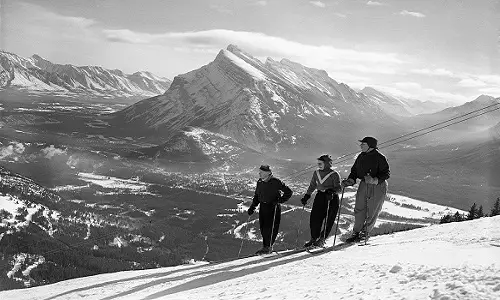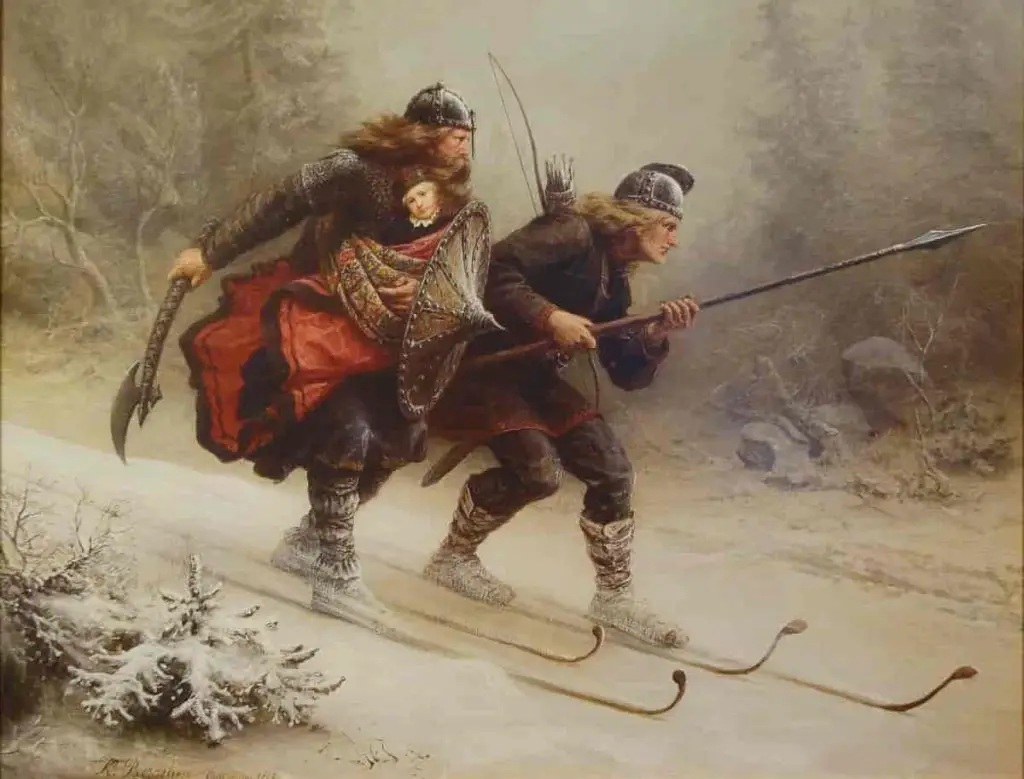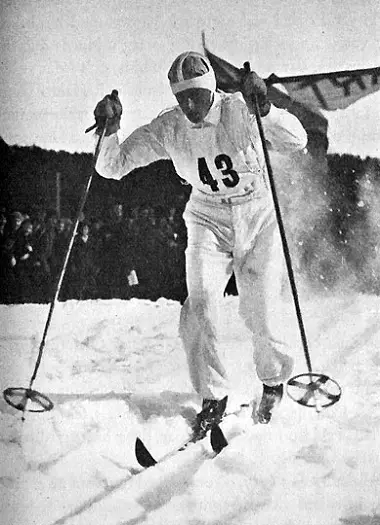Table of Contents
Let’s dive into the origin and deep history of cross-country skiing, that is truly the history of all forms of skiing!
There is still an ongoing debate where exactly cross-country skiing originated. Interestingly enough, there are three competitors in this race. As you would expect, the Scandinavian region is well-known for its skiing history, but at the same time drawings and actual remains of skis were found in Russia and China as well. In fact, many people still use skis up to this day in those particular regions. In the following, we will explore the facts we know for sure about the ancient history of cross-country skiing.
The Ancient Roots of Skiing
1206 AD – The Story of the Birkebeiner
In 1206, a civil war erupted between the Norwegian clans of Birkebeiner and Bagler. During this unrest, the peace-loving king called the Birkebeiner Haakon III passed away, and left a baby son behind, as the next in the throne. The Baglers made strategies to kill the son too.
It is during testing times like these that the king’s supporters and palace guards made a plan to escort the young king to Trondheim to save his life. The fierce snowstorm severely halted their mission only after a few days of traveling. But the heroic guards didn’t give up and bravely decided to push on by strapping their skis and carrying the young Haakon IV for a difficult 55 kilometers stretch from Lillehammar through the blizzard and snow and eventually to the safety of Rena, Trondheim.
In memory of their heroics, there are annual Birkebeiner races or loppets conducted in Norway to this day on the same path. The competitors can be seen with backpacks weighing 3.5 kilograms that is symbolic of the little king’s weight that the palace guards carried for 55 kilometers on skis.
Since then, Lillehammer has also hosted the Winter Olympics in 1994.
17th – 18th centuries: The Birth of the Biathlon
Early cross-country skiers relied on one long pole or spear as well as skis, as part of their gear. It was not until 1741 that we first saw a skier with two ski poles. Skis ranging up to 280 cm in length have been manufactured in Finland, with the longest one being recorded in Norway, at 373 cm!
Just as transport, military warfare also played an exceptional role in the history of cross-country skiing. Since Nordic skiing was also commonly employed by troops during wars to carry warfare. This was recorded for the first time by a Danish historian called Saxo Grammaticus in the 13th century. The transportation efforts of these troops using the skis were no efficient than those used through light cavalry.
The military in Trondheim has used skis from as early as 1675. The Danish-Norwegian garrison had specialized ski battalions since 1747, as per the records of military ski exercises in the year 1767. These military ski exercises have been noted since 1747. In 1799, Jacques de la Tocnaye (a French traveler) noted down the details of his visit to Norway in the form of a diary.
The Norwegian military was the first one to organize an official ski competition back in 1767. There were multiple cash prizes for skiing (that we today know as biathlon event), downhill skiing, and racing in full military gear, amongst other sporting activities.
The Revival of Skiing in the 19th century
19th century – Another huge step in the history of cross-country skiing: it becomes a recreational activity. At the beginning of the mid-1800s, cross-country skiing evolved from a transport-related activity to being a global recreational activity and winter sport in the world. Jacques de la Tocnaye (a French traveler) also mentioned Norwegian immigrants who were using skis in the US mid-west from 1836. The first skis in the USA were introduced by Norwegian emigrants.
The Terminology and Etymology of Skiing
When discussing the history of cross-country skiing, we cannot not mention Fridtjov Nansen (a Norwegian explorer, scientist, diplomat, humanitarian and Nobel Peace Prize laureate, who was also a champion skier and ice skater). Described the crossing of Greenland as På ski over Grønland, literally meaning “On skis across Greenland”, or ‘The first crossing of Greenland’ as per the English edition of the report.
He also noted that certain competitions require the skier to display skill in maneuvering his cross country ski to one side or another by staying within the confined markings, on a steep snow covered hill, and at great speed. He referred to these forms of jumping and slalom as “special arts”. However, he firmly believed that traveling was by far the most prominent part of skiing. By traveling, he meant “in an ordinary way across the country”.
The word ski is derived from the Old Norse word skíð, meaning “cleft wood”, “stick of wood” or “ski”.
In modern Norwegian, there are different terminologies to define cross-country skiing, such as:
Very few people are aware that the now international word slalom is a Norwegian word originating from Morgedal. Its first syllable, sla, means slope, hill or smooth surface and lam is the track down the slope. The normal slalam was a cross-country run over fields, hills and stone walls, weaving among thickets.
The Norwegian sports encyclopedia also adopts the term, skiløping, (literally meaning “ski running”) for all formats of skiing. Around the year 1900, the term Skilaufen gained traction in the German language and used in the same sense as Norwegians did, i.e. skiløping.
History of Competitive Cross-Country Skiing and the Olympics
Nordic ski or cross-country ski races (also referred to as langlauf in German and langrenn in a lot of Scandinavian languages) are conducted in circular courses. The distance of these international races is measured to be 10, 15, 30, and 50 km for men and 5, 10, 15, and 30 km for women.
A lot of traditional contests are for a longer duration such as the Vasaloppet in Sweden that is 90 km (56 miles). The race event organizers will specify the required techniques that are allowed in a particular event. Cross-country skiers will begin at intervals and those who reach the finish line in the shortest time are declared winners.
Fun fact, that the first official ski competitions were organized in 1767 by the Norwegian military. Multiple cash prizes were awarded for skiing (today known as biathlon), downhill skiing and racing in full military gear. When the Norwegian ski troops stopped functioning in 1826, it was local civilian ski clubs who re-started this sport by organizing the races and events again.
With Norwegians traveling and immigrating over the world in large numbers, they also introduced their unique methods of skiing to the respective indigenous population. It is at this point that cross country skiing was seen developing or evolving into a healthy and sociable sport from what it once used to be – a military practice or necessity.
During the complicated history of cross country skiing, some aspects have remained unchanged, such as the continued prominence and success of Scandinavian skiers. Soviet and Russian skiers also emerged strongly in the 1960s. Retired Norwegian ski champion Bjorn Daehlie has been the most successful Winter Olympian in history so far. He won 8 gold medals for Norway in 3 Winter Olympics within the period 1992 – 1998.
A renowned Canadian called Pierre Harvey has also won 3 World Cup gold medals from 1988 – 1989. Another notable Canadian ski champion called Angela Schmidt-Foster was also 4 time Olympian.
Norwegian Ove Aunli also found this technique to be quicker than the classic style and adopted it in 1984. Another development for skate skiing was introduced by the Finnish ski expert Pauli Siitonen in the 1970s, as he used a one-sided variant, by leaving one ski in the track and skating to the side with another ski, as part of endurance events. This became popular as the “marathon skate”.
The Evolution of Skate Skiing
The two renowned cross-country ski techniques include the classical, ancient method (traveling with diagonal strides, that is alternately kicking and gliding) or the skating or freestyle technique (that evolved relatively recently in the 1970s and is more akin to ice skating, and hence the name given to it).
Skate skiing started on an experimental basis in the 20th century, but only got the attention in the 1980s. Johan Grøttumsbråten was the one who adopted the skating technique during the 1931 World Championship in Oberhof – signifying a very early use of the technique in competitive cross-country skiing. Later on in the 1960s, the skating technique was adopted in ski orienteering on roads and other stable surfaces. It wasn’t until the 1980s when Bill Koch of USA took it up during cross-country ski championships.
Bill Koch first seen the skate step at a marathon event in Sweden, and he marveled how fast and efficient the skating motion is, compared to classic cross-country skiing. However, although it was free to use on a marathon event, at first FIS did not sanction skate (or freestyle) skiing by any means. Two years after Bill Koch’s first realization, he won the 1982 World Cup of Cross-Country Skiing by using the same technique.
There was a lot of controversy over skate or freestyle skiing, and in the first couple of years FIS hindered its triumph in every way they could. Still, after only five years, a number of new cross-country ski events were born for freestyle cross-country ski racing.
Final Thoughts
Since then, cross-country skiing is evolving and changing with extraordinary speed. The introduction of waxless cross-country skis and the latest technology, that is skin skis, changed the cross-country ski industry, recreational skiing and the professional cross-country ski scene completely.





